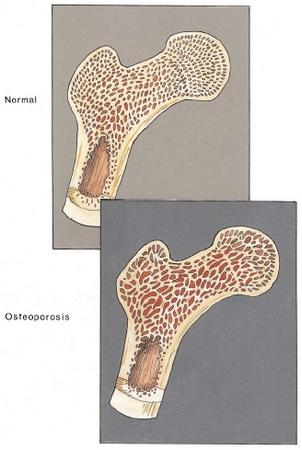Osteoporosis occurs when the body fails to form enough new bone, or when too much old bone is reabsorbed by the body, or both. Thin weakened bones are more likely to fracture. Fractures of the vertebrae, wrists, or hips are usually the first indication. Symptoms such as lower back, neck, bone pain or tenderness may not occur until late in the disease. Loss of estrogen in older women is the most common cause associated with this condition. Corticosteroids ( Prednisone for example) can lead to a loss in bone density and may cause
"secondary" osteoporosis in men and women of any age. Postmenopausal women taking corticosteroids are at a very great risk.
Calcium and phosphate are two minerals that are essential for normal bone formation. Throughout youth, the body uses these minerals to produce bones. If calcium intake is not sufficient, or if the body does not absorb enough calcium from the diet, bone production and bone tissues may suffer. Steroids { corticosteroids) inhibit the body's absorption of calcium through the intestine then encourage calcium loss via the kidneys. A very serious condition can result from damaged bone cells deprived of blood supply by fatty clots from steroids. The lack of of oxygen leads to "dead bone" called
avascular necrosis. Counteracting calcium depletion, slowing down or stopping bone loss, preventing bone fractures by minimizing the risk of falls, and controlling pain associated with the disease are the obvious goals for combating this health condition.






